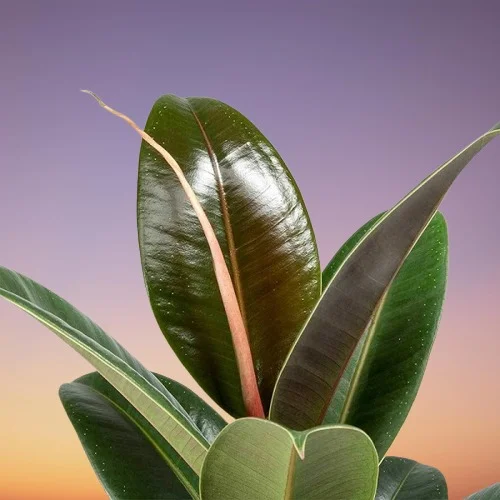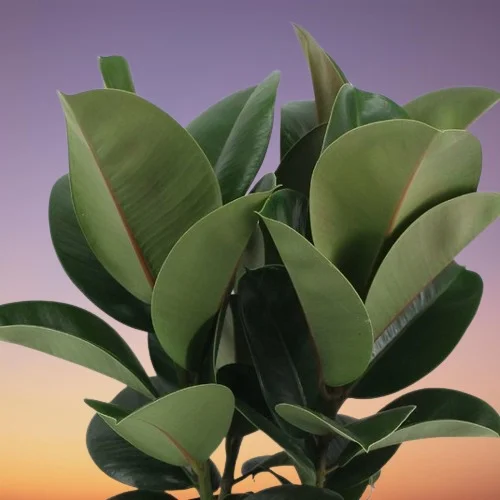11 Causes of Rubber Plant Leaves Turning Brown and their Remedies
Some links in this post may be affiliate links
Rubber Plant leaves are turning brown due to improper watering, pests infestations, root-rot, high temperatures, insufficient light, improper feeding, poor soil, being root-bound, age among others.
Rubber Plant is one of the easiest of the Ficus varieties for growing indoors. Rubber Plant thrives in bright light with 4-6 hours of direct sunshine, average warmth of 15-280C, moderate humidity of 50-55% and moderately moist, fertile, well-drained soil coupled with monthly feeding in the growing season. Learn how to grow and care for Rubber Plants (Ficus elastica).
Brown leaves on your Rubber Plant are an indication that the growing conditions are not right. Below we have discussed 11 causes of brown leaves in Rubber Plant. Keep on reading for more on these causes and how to fix them.
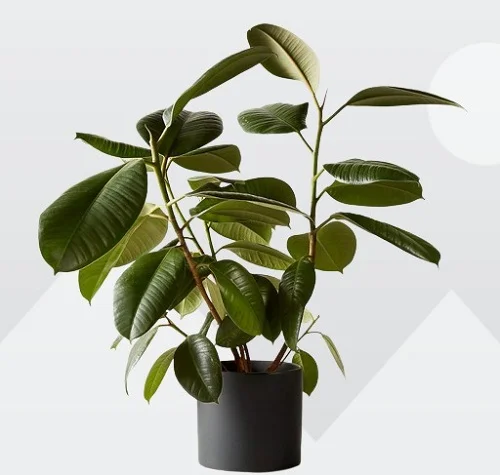
11 Reasons Rubber Plant Leaves are Turning Brown & Solutions
1. Overwatering
Overwatering your Rubber Plant leads to soggy soil (excess water in the soil). Too much water in the soil reduces the oxygen concentration in the rootzone. This causes the roots to die due to root-rot. When roots die, they cannot take up water to the leaves, they wilt due to dehydration, turn brown and begin to die.
Solutions
Carefully slip the plant out of its pot and inspect the roots. Brown-black mushy roots indicate root-rot, trim them off and treat the healthy roots with a fungicidal solution.
Disinfect the pot with the fungicidal solution or use a fresh pot to repot the plant in fresh free-draining soil. Do not water the plant and keep it dry for some time before resuming watering.
To avoid getting soggy soil, ensure that the pot has a drainage hole and the soil is free-draining. Allow the top 2-3 inches of soil to dry out between waterings. Cut down on watering in the cold season to maintain the soil slightly moist as growth is minimal at this time.
2. Underwatering
Underwatering means that there is too little moisture in the soil for the Rubber Plant to take up to the leaves. As such, the plant cannot take up nutrients and water to the leaves. Therefore, they wilt, turn brown and begin to die.
Solutions
Water your Rubber Plant liberally during the growing season until it comes out through the drainage holes while allowing the top 2-3 inches of soil to dry out between waterings. Reduce watering during the cold season and do not let the soil dry out completely but maintain the soil slightly moist.
3. Pest Infestations
Rubber Plant is prone to spider mites, aphids, scale insects and mealy bugs which attack the new growth from where they suck the plant sap. This causes the plant to become dehydrated and results in the leaves wilting and browning of the leaves.
Solutions
Regularly inspect your Rubber Plant for these pests and take timely control measures. Treat the infected plant with neem oil or insecticidal soap as per the manufacturer's instructions.
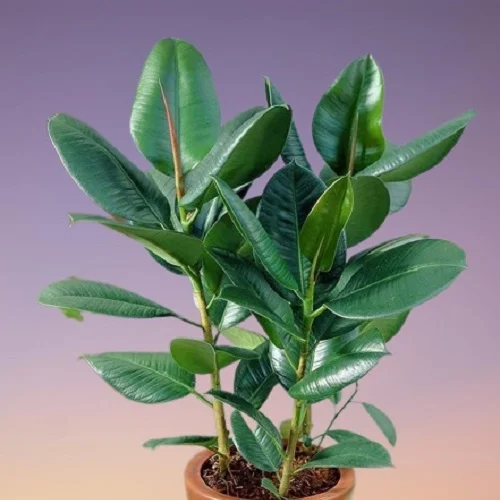
4. Poor Quality Soil
Poor quality soil does not drain easily and therefore it easily becomes compacted or soggy which can negatively impact the growth . Rubber Plant prospers in loose, free-draining, all purpose soil that does not hold excessive amounts of water as soggy soil can lead to root-rot disease which is characterized by yellowing, browning and dropping leaves.
Solutions
Pot and repot your Rubber Plant in good quality soil that is loose, well-drained and rich in organic matter. All purpose potting soils are perfect for this plant.
5. Root-bound Plant
If Rubber Plant is root-bound, the roots have filled the pot and there is very little soil to hold water when you water the plant. Therefore, there is no water for the plant to take up to the leaves. The leaves loss their stiffness and they wilt, turn brown and drop.
Solutions
Check the bottom of the pot for roots growing through the drainage hole and repot your Rubber Plant into a pot one size larger than the current one.
Make sure that the pot has a drainage hole and that the soil is loose and well-drained. Use a heavy pot as the plant can become top-heavy and topple over. Check out these ceramic pots with a drainage hole on Amazon.
6. Repotting Shock
Repotting may cause your Rubber Plant some shock which may lead to some leaves wilting, turning brown and dropping before it can adjust to the new growing conditions.
Solutions
To minimize repotting shock, water the plant thoroughly one day before repotting. A well hydrated plant experiences less shock. Do not make too many changes at once. For instance, after repotting, maintain the plant in the same location until it is well established before moving it to a new location.
7. Too Little Light
Rubber Plant grows best in bright light with some direct sunshine to thrive. The light is needed for making food that is required for energy and growth. If the light is insufficient the plant cannot make enough food for energy and growth. In an attempt to save energy, the plant begins to die from the leaves. They turn yellow, brown and eventually die.
Solutions
Move your Rubber Plant to a brighter spot where it will receive bright light with 4-6 hours of morning or late afternoon sunshine. You may also instal a full spectrum grow light if natural light in your home is not adequate.
Regularly rotate the pot to ensure that the plant absorbs enough light for photosynthesis on all sides and also avoid leggy growth.
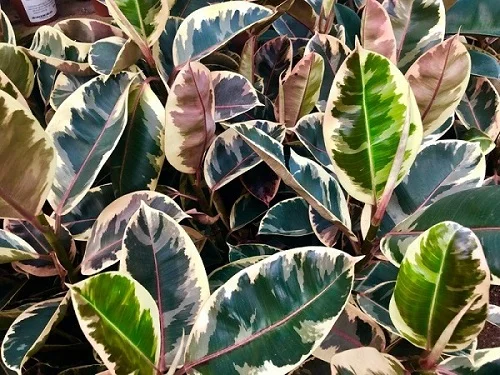
8. Overfeeding
Overfeeding Rubber Plant will cause the roots to die due to fertilizer burn. When the roots die, they cannot take up water to the leaves. Without adequate water, the leaves get dehydrated, they wilt, turn brown and die.
Solutions
Take care not to overfeed the plant. Feed your Rubber Plant during the growing season with a balanced, water-soluble fertilizer and follow the instructions on the label to avoid overfeeding. Do not feed the plant during the cold season as growth is minimal at this time and feeding at this time can lead to fertilizer burn.
Flush out the salts from the soil regularly by running a stream of water through the soil until it comes out through the drainage holes and repeat the process several times.
9. Underfeeding
Underfeeding implies that the Rubber Plant is not getting enough nutrients need for growth and energy. Inadequate nutrients in the actively growing tips causes nutrients to be withdrawn from the older lower leaves which turn yellow, brown and drop.
Solutions
Feed Rubber Plant during the growing period with a balanced, water-soluble fertilizer and follow the instructions to avoid underfeeding.
10. Too Hot Temperatures
Rubber Plant requires average warmth of 15-280C for optimum growth. Extremely hot temperatures above the optimum range will cause dehydration of the leaves resulting in wilting, browning and eventually dropping.
Solutions
Keep your Rubber Plant away from hot drafts like hot surfaces, hot air vents and other hot areas to prevent extremely high temperatures. Maintain an average temperature of 15-280C. A room temperature that is comfortable for you is ideal for the plant.
11. Aging
As the Rubber Plant matures, it loses the lower leaves leaving a bare stem with a crown of leaves at the top. The leaves turn yellow, then brown and eventually drop.
Solutions
Cut back the Rubber Fig stem at the desired height to rejuvenate growth. New growth should sprout just below the cut into a new bushy plant.
You liked it? Share on social media.
Related Content
Amazon Associates Disclosure
Homeplantsguide.com is a participant in the Amazon Services LLC Associates Program, an affiliate advertising program designed to provide a means for sites to earn advertising fees by advertising and linking to amazon.com.



